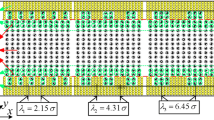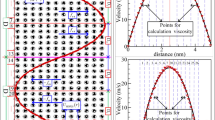Abstract
In this work, the viscosity–temperature–density relationship of methane is investigated for three fully atomistic models (RISM, OPLS and MOPLS) and the corresponding coarse-grained models (CGRISM, CGOPLS and CGMOPLS) by studying the Poiseuille flow inside a silicon nano-channel using molecular dynamic simulation. In order to solve the interaction problem of nano-channel atom and methane molecule, the coarse-grained methane model and the classical Berthelot–Lorentz mixing rules are employed. The optimized coarse-grained methane models are determined using the relative entropy minimization method. The density distribution, stress force profile and velocity profile of coarse-grained models are compared with the fully atomistic models for different nano-channel widths. It is concluded that the results of coarse-grained model are in reasonable agreement with those of the corresponding fully atomistic model. Furthermore, the value of viscosity is calculated by fitting the velocity profile to the continuum solution from the Navier–Stokes equations and then compared to experimental value. The results show that the MOPLS and CGMOPLS models could well predict the viscosity of methane fluid, while the OPLS model performed worst. All simulation results indicate that the coarse-grained models can be used to predict the viscosity of methane fluid accurately.






Similar content being viewed by others
References
Abbaspour M (2011) Computation of some thermodynamics, transport, structural properties, and new equation of state for fluid methane using two-body and three-body intermolecular potentials from molecular dynamics simulation. J Mol Liq 161:30–35
Allen MP, Tildesley DJ (1989) Computer simulation of liquids. Oxford University Press
Arya G, Maginn EJ, Chang H-C (2000) Efficient viscosity estimation from molecular dynamics simulation via momentum impulse relaxation. J Chem Phys 113:2079–2087
Backer J, Lowe C, Hoefsloot H, Iedema P (2005) Poiseuille flow to measure the viscosity of particle model fluids. J Chem Phys 122:154503
Beerling D, Berner RA, Mackenzie FT, Harfoot MB, Pyle JA (2009) Methane and the CH4 related greenhouse effect over the past 400 million years. Am J Sci 309:97–113
Bhadauria R, Aluru N (2013) A quasi-continuum hydrodynamic model for slit shaped nanochannel flow. J Chem Phys 139:074109
Bhadauria R, Sanghi T, Aluru N (2015) Interfacial friction based quasi-continuum hydrodynamical model for nanofluidic transport of water. J Chem Phys 143:174702
Bird RB (2002) Transport phenomena. Appl Mech Rev 55:R1–R4
Bird R, Stewart W, Lightfoot E (1960) Transport phenomena. Wiley, New York, pp 59, 67
Boon J-P, Legros JC, Thomaes G (1967) On the principle of corresponding states for the viscosity of simple liquids. Physica 33:547–557
Bruhn D, Møller IM, Mikkelsen TN, Ambus P (2012) Terrestrial plant methane production and emission. Physiol Plant 144:201–209
Chan DY, Horn R (1985) The drainage of thin liquid films between solid surfaces. J Chem Phys 83:5311–5324
Diller DE (1980) Measurements of the viscosity of compressed gaseous and liquid methane. Phys A 104:417–426
El-Sheikh SM, Barakat K, Salem NM (2006) Phase transitions of methane using molecular dynamics simulations. J Chem Phys 124(12):124517
Frenkel D, Smit B (2001) Understanding molecular simulation: from algorithms to applications. Academic press, New Jersey
García-Rojo R, Luding S, Brey JJ (2006) Transport coefficients for dense hard-disk systems. Phys Rev E 74:061305
Goodwin AR (2008) A MEMS vibrating edge supported plate for the simultaneous measurement of density and viscosity: results for argon, nitrogen, and methane at temperatures from (297 to 373) K and pressures between (1 and 62) MPa. J Chem Eng Data 54:536–541
Gosling EM, McDonald I, Singer K (1973) On the calculation by molecular dynamics of the shear viscosity of a simple fluid. Mol Phys 26:1475–1484
Habenschuss A, Johnson E, Narten A (1981) X-ray diffraction study and models of liquid methane at 92 K. J Chem Phys 74:5234–5241
Haile J (1993) Molecular dynamics simulation: elementary methods. Comput Phys 7:625
Hanley HJ, McCarty RD, Haynes WM (1974) The viscosity and thermal conductivity coefficients for dense gaseous and liquid argon, krypton, xenon, nitrogen, and oxygen. J Phys Chem Ref Data 3:979–1017
Hanley HJ, Haynes WM, McCarty RD (1977) The viscosity and thermal conductivity coefficients for dense gaseous and liquid methane. J Phys Chem Ref Data 6:597–610
Hansen J-P, McDonald IR (1990) Theory of simple liquids. Elsevier, New York
Hartkamp R, Ghosh A, Weinhart T, Luding S (2012) A study of the anisotropy of stress in a fluid confined in a nanochannel. J Chem Phys 137:044711
Haynes W (1973) Viscosity of saturated liquid methane. Physica 70:410–412
Hess B (2002) Determining the shear viscosity of model liquids from molecular dynamics simulations. J Chem Phys 116:209–217
Heyes DM (1988) Transport coefficients of Lennard–Jones fluids: a molecular-dynamics and effective-hard-sphere treatment. Phys Rev B 37:5677
Horsch M, Vrabec J, Bernreuther M, Hasse H (2009) Poiseuille flow of liquidmethane in nanoscopic graphite channels by molecular dynamics simulation. In ICHMT digital library online. Begel House Inc, Danbury
Hu C, Bai M, Lv J, Kou Z, Li X (2015) Molecular dynamics simulation on the tribology properties of two hard nanoparticles (diamond and silicon dioxide) confined by two iron blocks. Tribol Int 90:297–305
Hurly J, Gillis K, Mehl J, Moldover M (2003) The viscosity of seven gases measured with a greenspan viscometer. Int J Thermophys 24:1441–1474
Jiang C, Ouyang J, Zhuang X, Wang L, Li W (2016) An efficient fully atomistic potential model for dense fluid methane. J Mol Struct 1117:192–200
Jorgensen WL, Madura JD, Swenson CJ (1984) Optimized intermolecular potential functions for liquid hydrocarbons. J Am Chem Soc 106:6638–6646
Kamal C, Chakrabarti A, Banerjee A, Deb S (2013) Silicene beyond mono-layers-different stacking configurations and their properties. J Phys Condens Mat 25:085508
Karniadakis GE, Beskok A, Aluru N (2006) Microflows and nanoflows: fundamentals and simulation. Springer, New York
Kim JM, Phillips RJ (2004) Dissipative particle dynamics simulation of flow around spheres and cylinders at finite Reynolds numbers. Chem Eng Sci 59:4155–4168
Kong CL (1973) Combining rules for intermolecular potential parameters. II. Rules for the Lennard–Jones (12–6) potential and the Morse potential. J Chem Phys 59:2464–2467
Li T-D, Gao J, Szoszkiewicz R, Landman U, Riedo E (2007) Structured and viscous water in subnanometer gaps. Phys Rev B 75:115415
Markesteijn A, Hartkamp R, Luding S, Westerweel J (2012) A comparison of the value of viscosity for several water models using Poiseuille flow in a nano-channel. J Chem Phys 136:134104
Mashayak S, Aluru N (2012a) Coarse-grained potential model for structural prediction of confined water. J Chem Theory Comput 8:1828–1840
Mashayak S, Aluru N (2012b) Thermodynamic state-dependent structure-based coarse-graining of confined water. J Chem Phys 137:214707
Matthews GP, Smith EB (1976) An intermolecular pair potential energy function for methane. Mol Phys 32:1719–1729
Meda B, Flechard C, Germain K, Robin P, Walter C, Hassouna M (2012) Greenhouse gas emissions from the grassy outdoor run of organic broilers. Biogeosciences 9:1493–1508
Mei J, Diao Y, Appleton AL, Fang L, Bao Z (2013) Integrated materials design of organic semiconductors for field-effect transistors. J Am Chem Soc 135:6724–6746
Meier K, Laesecke A, Kabelac S (2004) Transport coefficients of the Lennard–Jones model fluid. I. Viscosity. J Chem Phys 121:3671–3687
Meier K, Laesecke A, Kabelac S (2005) Transport coefficients of the Lennard–Jones model fluid. III. Bulk viscosity. J Chem Phys 122:014513
Murad S, Evans D, Gubbins K, Streett W, Tildesley D (1979) Molecular dynamics simulation of dense fluid methane. Mol Phys 37:725–736
Poling BE, Prausnitz JM, O’connell JP (2001) The properties of gases and liquids. McGraw-Hill, New York
Ranjith SK, Patnaik B, Vedantam S (2013) No-slip boundary condition in finite-size dissipative particle dynamics. J Comput Phys 232:174–188
Rapaport DC (2004) The art of molecular dynamics simulation. Cambridge University Press, Cambridge
Righini R, Maki K, Klein ML (1981) An intermolecular potential for methane. Chem Phys Lett 80:301–305
Sadus RJ (2002) Molecular simulation of fluids. Elsevier, New York
Schiermeier Q (2006) Methane finding baffles scientists. Nature 439:128
Schley P, Jaeschke M, Küchenmeister C, Vogel E (2004) Viscosity measurements and predictions for natural gas. Int J Therm 25:1623–1652
Shell MS (2008) The relative entropy is fundamental to multiscale and inverse thermodynamic problems. J Chem Phys 129:108
Stassen H (1999) On the pair potential in dense fluid methane. J Mol Struct Theochem 464:107–119
Sun C-Z, Lu W-Q, Bai B-F, Liu J (2014) Novel flow behaviors induced by a solid particle in nanochannels: Poiseuille and Couette. Chin Sci Bull 59:2478–2485
Travis KP, Todd B, Evans DJ (1997) Departure from Navier-Stokes hydrodynamics in confined liquids. Phys Rev E 55:4288
Van Der Gulik P, Mostert R, Van den Berg H (1992) The viscosity of methane at 273 K up to 1 GPa. Fluid Phase Equilib 79:301–311
Williams DE (1966) Nonbonded potential parameters derived from crystalline aromatic hydrocarbons. J Chem Phys 45:3770–3778
Xu J, Zhou Z, Xu X (2004) Molecular dynamics simulation of micro-Poiseuille flow for liquid argon in nanoscale. Int J Numer Method H 14:664–688
Zarkova L, Hohm U, Damyanova M (2006) Viscosity, second pVT-virial coefficient, and diffusion of pure and mixed small alkanes CH4, C2H6, C3H8, n-C4H10, i-C4H10, n-C5H12, i-C5H12, and C(CH3)4 calculated by means of an isotropic temperature-dependent potential. I. Pure alkanes. J Phys Chem Ref Data 35:1331–1364
Zhang C, Duan Z, Zhang Z (2007) Molecular dynamics simulation of the CH4 and CH4–H2O systems up to 10 GPa and 2573K. Geochim Cosmochim Acta 71:2036–2055
Ziarani A, Mohamad A (2006) A molecular dynamics study of perturbed Poiseuille flow in a nanochannel. Microfluid Nanofluid 2:12–20
Acknowledgements
We gratefully acknowledge the anonymous referees for the valuable suggestions and discussions that helped improving the paper clarity and readability. This work is financially supported by the National Basic Research Program of China (973 Program) (Grant No. 2012CB025903), the Major Research Plan of the National Natural Science Foundation of China (Grant No. 91434201) and the National Natural Science Foundation of China (Grant No. 11402210).
Author information
Authors and Affiliations
Corresponding author
Rights and permissions
About this article
Cite this article
Jiang, C., Ouyang, J., Liu, Q. et al. Studying the viscosity of methane fluid for different resolution levels models using Poiseuille flow in a nano-channel. Microfluid Nanofluid 20, 157 (2016). https://doi.org/10.1007/s10404-016-1824-0
Received:
Accepted:
Published:
DOI: https://doi.org/10.1007/s10404-016-1824-0




